Algeria
UTC+1 (Central European Time)
No daylight saving time observed
Single time zone throughout the country
Algerian Dinar (DZD)
Symbol: د.ج
ATMs available in major cities. Cash is widely used for most transactions.
July 5, 1962 (from France)
Independence Day is the national holiday
Rich history dating back to ancient Numidian kingdoms and Berber civilizations
Visa-Free Countries
Visa on Arrival Countries
E-Visa Countries
Visa Required Countries
Culture
Algeria's cultural identity is a rich tapestry woven from diverse influences, reflecting its strategic position at the crossroads of the Mediterranean, Africa, and the Middle East. This North African nation's heritage has been shaped by indigenous Amazigh (Berber) traditions, Arab-Islamic civilization, and elements of Mediterranean, Ottoman, and French colonial influences, creating a distinctive cultural landscape that continues to evolve.
Key elements of Algerian culture include:
- Berber heritage: The indigenous Amazigh (Berber) peoples have inhabited North Africa for millennia, contributing foundational elements to Algerian culture. Amazigh communities preserve distinctive traditions, languages (Tamazight is now an official language alongside Arabic), music, crafts, and celebrations. Regions like Kabylia, the Aurès, and the M'zab valley maintain particularly strong Berber cultural identities with unique architectural styles, textile arts, and social customs.
- Islamic traditions: Islam arrived in the 7th century and profoundly shaped Algerian culture. The majority of Algerians practice Sunni Islam of the Maliki school, with religious practices intertwined with daily life and social institutions. Islamic holidays like Eid al-Fitr, Eid al-Adha, and Mawlid (the Prophet's birthday) are major celebrations featuring special foods, family gatherings, and community prayers. Religious architecture, from grand Ottoman-era mosques to the unique M'zab pentapolis designed by Ibadi Muslims, reflects the diversity of Islamic expression in Algeria.
- Traditional crafts: Algeria has a vibrant tradition of handicrafts that combines aesthetic beauty with practical function. These include intricate carpet weaving (particularly from the Djurdjura and Ghardaïa regions), pottery (with distinctive styles from regions like Kabylia featuring geometric Berber symbols), copper and metalwork, leather goods, and jewelry making. The distinctive blue-washed houses of coastal cities like Algiers reflect Mediterranean influences, while the earthen architecture of southern oasis towns demonstrates adaptation to desert environments.
- Music and performance: Algerian music encompasses diverse traditions, from Andalusian classical music (inherited from Islamic Spain) to Raï (a popular music style that originated in Oran). Chaabi music emerged from the casbah of Algiers, while Gnawa music reflects Sub-Saharan African influences. Traditional instruments include the oud, qanun, derbouka (drum), and gasba (flute). Algerian cinema has gained international recognition, with filmmakers addressing historical, social, and political themes that resonate beyond national borders.
- Literary traditions: Algeria has a rich literary heritage in multiple languages. Oral storytelling traditions remain important, preserving folk tales, proverbs, and historical narratives. The country has produced internationally acclaimed authors writing in Arabic, French, and Tamazight, including Nobel Prize nominee Kateb Yacine, Mohammed Dib, Assia Djebar, and Kamel Daoud, whose works often explore themes of identity, colonization, independence, and social change.
Algerian cuisine reflects the country's geographical diversity and historical influences:
- National dishes: Couscous is undoubtedly Algeria's most iconic dish, consisting of steamed semolina served with a vegetable and meat stew (typically lamb or chicken), recognized by UNESCO as intangible cultural heritage. Regional variations exist throughout the country, with different combinations of vegetables, meats, and spice profiles. Other popular dishes include chakhchoukha (torn flatbread with a tomato and meat sauce), dolma (stuffed vegetables), and bourek (savory pastries filled with meat, egg, or cheese).
- Bread traditions: Bread holds central importance in Algerian cuisine and culture. Varieties include kesra (a traditional flatbread), mtabga (a layered pan-fried bread), and numerous regional specialties. Bread accompanies almost every meal and is treated with respect, reflecting cultural values around food and abundance.
- Tea and coffee culture: Mint tea is a symbol of hospitality throughout Algeria, typically prepared with green tea, fresh mint leaves, and plenty of sugar. Coffee is also important, often prepared as a strong, cardamom-infused "café Turc" (Turkish coffee). Offering tea or coffee to visitors is a fundamental expression of welcome and respect in Algerian homes.
- Sweets and pastries: Algeria is renowned for its elaborate pastries, often featuring honey, almonds, sesame, and orange blossom or rose water. Favorites include makroud (date-filled semolina cookies), kalb el louz (semolina cake soaked in syrup), and zlabiya (fried dough soaked in honey, especially popular during Ramadan). Many of these sweets reflect Andalusian and Ottoman influences.
- Seasonal and celebratory foods: Special dishes mark religious and cultural celebrations, such as chorba (soup) and bourek during Ramadan, couscous with dried meat for Eid al-Adha, and rfis (sweet couscous with dates) for births and weddings. Seasonal celebrations often highlight local agricultural products, such as olive harvests in Kabylia or date harvests in southern oases.
Modern Algerian culture continues to evolve while maintaining connections to its deep historical roots. Family remains central to Algerian society, with extended family networks providing social support and intergenerational households still common. Urban areas like Algiers showcase contemporary art galleries, theaters, and universities where cultural innovation flourishes alongside traditional practices. Youth culture blends global influences with local expressions, evident in the popularity of fusion music, street art, and digital media. Annual festivals celebrate everything from traditional Tuareg culture in the Sahara to contemporary cinema in Algiers, highlighting Algeria's dynamic cultural landscape. Despite periods of political and social challenge, Algerians maintain strong pride in their cultural heritage, which continues to serve as a source of national identity and resilience.
Tourism & Best Sites to Visit
Algeria, Africa's largest country by area, offers travelers an extraordinary blend of Mediterranean coastlines, dramatic mountain ranges, vast Saharan landscapes, and well-preserved ancient Roman ruins—all enriched by a distinctive cultural heritage. Though less developed for tourism than its neighbors Morocco and Tunisia, Algeria rewards adventurous travelers with authentic experiences and sites of breathtaking beauty largely unmarred by mass tourism.
Here are some of Algeria's most remarkable destinations:
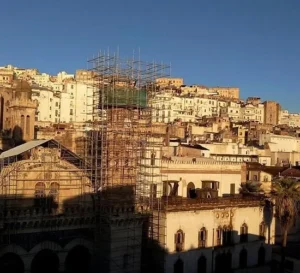
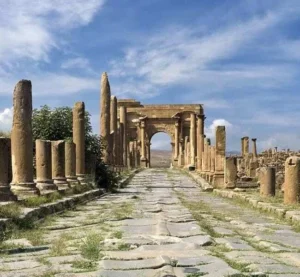
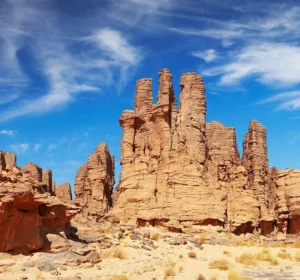
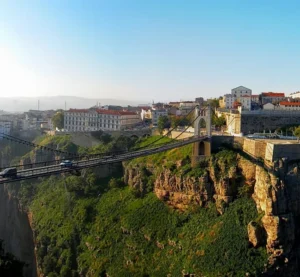
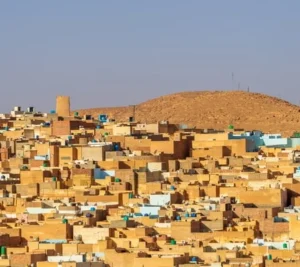
Algiers: Algeria's capital offers a fascinating blend of Mediterranean charm and Islamic heritage. The UNESCO-listed Casbah (old city) is a labyrinth of narrow alleys, Ottoman palaces, and historic mosques cascading down to the sea. The city's French colonial heritage is evident in the elegant boulevards and buildings of the downtown area, while modern Algiers showcases contemporary North African urban life. Key attractions include the imposing Great Mosque, the National Museum of Antiquities, the majestic Notre Dame d'Afrique basilica overlooking the Bay of Algiers, and the striking Martyrs' Memorial (Maqam Echahid) commemorating the Algerian War of Independence.
Roman Ruins: Algeria possesses some of North Africa's most impressive Roman sites, often in remarkably well-preserved condition. Timgad (ancient Thamugadi) stands out as a perfectly preserved Roman colonial town with its distinctive grid layout, triumphant arch, and 3,500-seat theater. Djémila (ancient Cuicul), another UNESCO site, features extraordinary mosaics and impressive public buildings nestled in a stunning mountain setting. Tipaza combines Roman ruins with breathtaking Mediterranean views, while Hippo Regius (modern Annaba) was once home to St. Augustine and features extensive archaeological remains including ancient Christian basilicas.
Saharan Treasures: The vast Algerian Sahara contains some of the desert's most extraordinary landscapes. The UNESCO-listed Tassili n'Ajjer National Park features surreal rock formations and thousands of prehistoric rock paintings and engravings dating back to 6000 BCE. The dunes of the Grand Erg Oriental and Erg Occidental offer classic Saharan experiences, while the stunning red rock landscapes of Hoggar Mountains near Tamanrasset feature dramatic volcanic formations. Oasis towns like Timimoun, with its distinctive red buildings, and Djanet provide gateways to desert exploration and insights into traditional Saharan lifestyles.
Constantine: Often called the "City of Bridges," Constantine is dramatically situated on a rocky plateau surrounded by deep gorges. Its spectacular setting features natural bridges and man-made spans connecting parts of the city across deep ravines. The Sidi M'Cid suspension bridge offers breathtaking views, while the old town contains historic mosques, medersas (Islamic schools), and the Palace of Ahmed Bey. The city's unique geography and blend of Berber, Arab, Turkish, and French influences create a distinctive atmosphere unlike anywhere else in North Africa.
Kabylia and Tell Atlas: The mountainous region of Kabylia, home to Algeria's largest Berber community, offers stunning landscapes of forested mountains, traditional villages, and distinctive cultural experiences. The coastal city of Béjaïa combines a beautiful Mediterranean setting with historic monuments including the Casbah and Spanish fortress. Outdoor enthusiasts can explore Djurdjura National Park, with its spectacular limestone formations, cedar forests, and hiking opportunities. Throughout the region, visitors can experience traditional Kabyle hospitality, cuisine, and crafts, including distinctive pottery and jewelry.
M'zab Valley: This UNESCO World Heritage site features five fortified cities (Ghardaïa, Melika, Beni Isguen, Bounoura, and El Atteuf) built by the Ibadi Muslims in the 10th century. The distinctive architecture features white buildings with pyramid-shaped minarets, ingenious water management systems, and integrated palm groves. The geometric urban planning and unique social organization of these cities have fascinated architects and urban planners for generations. Visitors can explore traditional markets, observe distinctive craft traditions, and witness a way of life that has maintained continuity for a millennium.
Beyond these highlights, other remarkable destinations include Oran, Algeria's vibrant second city known for its Spanish-influenced architecture and Raï music; the Roman ruins of Tiddis, dramatically perched on a hillside; the coastal national parks of El Kala and Gouraya, offering pristine Mediterranean landscapes; and Taghit, a picturesque desert oasis with ancient rock carvings and magnificent sand dunes. For adventurous travelers, the remote Tassili du Hoggar and Tuat region offer extraordinary desert landscapes and encounters with Tuareg culture.
Transportation
Transportation in Algeria has seen significant development in recent years, with major investments in infrastructure expanding options for travelers. While the transportation network is reasonably comprehensive in northern cities, more remote areas may present greater challenges for visitors.
- Railways: Algeria's railway network primarily serves the northern part of the country, with the main line running parallel to the Mediterranean coast connecting major cities like Algiers, Oran, Constantine, and Annaba. The national railway company SNTF has invested in modernizing its fleet and tracks, introducing high-speed services on some routes. Trains offer an economical and generally comfortable option for intercity travel, though schedules may be limited compared to road transport. First and second-class options are available on most routes, and advance booking is recommended, especially for longer journeys. Tickets can be purchased at station counters or through the SNTF website, though the online system may not always be accessible to international travelers.
- Domestic flights: Air Algérie operates an extensive network of domestic flights connecting Algiers with regional centers including Oran, Constantine, Annaba, Tlemcen, Tamanrasset, Ghardaïa, and Djanet. For travelers planning to visit southern destinations like the Sahara, flying is often the most practical option given the vast distances involved. Smaller airlines like Tassili Airlines also serve domestic routes. Flights tend to be reasonably priced and can save significant time, though schedules may be subject to changes or cancellations, particularly in adverse weather conditions. Booking through a travel agent familiar with the Algerian market can be helpful for navigating the reservation system.
- Buses and shared taxis: Long-distance buses connect most cities and towns across Algeria, operated by both government companies and private operators. Standards vary widely, from basic services to air-conditioned coaches with reserved seating. For shorter intercity routes, shared collective taxis (louages) are popular, typically departing when full from designated stations in each city. These offer greater speed and flexibility than buses, though with less space for luggage. In more remote areas, especially in the south, 4x4 vehicles may serve as shared transport between settlements. For visitors unfamiliar with routes and systems, having a local guide or contact assist with arrangements can be invaluable.
-
Urban transportation: Within cities, options include:
- Algiers has a modern metro system with two lines serving central areas, complemented by tramway lines in Algiers, Oran, Constantine, Sétif, and other major cities
- Public buses operate in all major cities, though routes and schedules may not be readily available in languages other than Arabic or French
- Taxis are plentiful and relatively inexpensive, with both metered services in larger cities and fixed-price rides in smaller towns
- App-based ride services like Yassir (an Algerian equivalent to Uber) operate in major urban centers, offering a convenient alternative that avoids language barriers
- Private car hire: For maximum flexibility, hiring a car with a driver is highly recommended rather than self-driving. Local drivers understand road conditions, navigation challenges, and can assist with interactions at checkpoints. For desert exploration, specialized tour operators offer 4x4 excursions with experienced drivers familiar with Saharan terrain. While international car rental agencies operate in Algeria, self-driving requires significant preparation and familiarity with local driving customs, which can be challenging for visitors.
-
Special considerations: Travel in more remote areas, particularly in the Sahara region, often requires specialized arrangements:
- Desert excursions should be arranged through established tour operators with proper permits and experienced guides
- Some areas, particularly near borders, may have travel restrictions requiring special permissions
- For longer desert journeys, travelers should be prepared for basic conditions and carry adequate supplies
Transportation tips: Consider these factors when planning travel in Algeria:
- Algeria is a vast country (the largest in Africa), and distances between destinations can be substantial – Algiers to Tamanrasset is over 1,500 km
- Combining transportation modes often provides the most efficient itinerary – such as flying to southern destinations and using ground transport for regional exploration
- Weather can affect transportation, particularly in winter months when mountain roads may be affected by snow, and desert travel can be impacted by sandstorms in spring
- Security checkpoints are common on major routes, and travelers should always carry identification documents
- For historic city centers like the Casbah in Algiers or the M'zab Valley towns, many areas are only accessible on foot due to narrow streets and stairways
Airports
Algeria has invested significantly in modernizing its aviation infrastructure, with several international and domestic airports serving the country. These facilities connect Algeria to major global destinations and provide vital links between regions within this vast nation, particularly important given the challenging terrain and great distances involved.
- Houari Boumediene Airport (ALG): Algeria's primary international gateway, located about 20 km southeast of central Algiers, handles approximately 7-8 million passengers annually. The airport features modern terminals with a range of amenities including duty-free shops, restaurants, prayer rooms, and banking services. The national carrier, Air Algérie, operates its hub here, offering connections throughout Africa, Europe, the Middle East, and North America. Other airlines serving Algiers include Air France, Turkish Airlines, Lufthansa, Qatar Airways, and Royal Air Maroc. The airport serves as the main entry point for most international visitors and connects to domestic destinations throughout the country.
- Oran Es Sénia Airport (ORN): Serving Algeria's second-largest city, this international airport connects Oran to destinations in Europe and across North Africa, as well as offering frequent domestic connections. Following recent modernization, the facility provides good passenger amenities and services. Located approximately 10 km from the city center, the airport serves as an important gateway to western Algeria, including access to the Roman ruins at Tipaza and the coastal regions around Oran.
- Constantine Mohamed Boudiaf Airport (CZL): This international airport serves eastern Algeria and has undergone significant expansion to accommodate growing passenger numbers. It offers international connections to France, Turkey, and various Middle Eastern destinations, along with domestic flights to Algiers and other Algerian cities. The modern terminal provides standard amenities for travelers, and the airport is located about 7 km from Constantine's city center.
- Annaba Rabah Bitat Airport (AAE): Serving the northeastern coastal city of Annaba, this airport offers international flights to France and Tunisia, as well as domestic connections. The facility provides access to important archaeological sites including Hippo Regius and the beautiful coastal regions of northeastern Algeria. Though smaller than the major hubs, it offers necessary passenger services and is located approximately 9 km from the city center.
-
Saharan airports: Critical for accessing Algeria's vast southern regions, these include:
- Tamanrasset Aguenar Airport (TMR): The primary gateway to the Hoggar Mountains and southern Sahara
- Djanet Inedbirene Airport (DJG): Providing access to the UNESCO-listed Tassili n'Ajjer National Park
- Ghardaïa Noumérat Airport (GHA): Serving the M'zab Valley region
- Tindouf Airport (TIN): Located in the far southwest of the country
Airport Transportation: Options for reaching your destination from major airports include:
- Houari Boumediene Airport (Algiers): Public buses connect the airport to various points in Algiers, though they can be challenging for visitors with limited French or Arabic. Airport taxis operate with fixed rates to different zones in Algiers, providing the most convenient option for most travelers. Some hotels offer shuttle services with advance arrangement. A new rail link is under development but not yet operational.
- Regional airports: Taxis are the primary transportation option from smaller airports, with rates typically negotiated or fixed depending on the destination. Having your accommodation arrange airport pickup can be particularly helpful at provincial airports, where transport options may be more limited, especially for late arrivals.
Important notes: Airport security in Algeria is comprehensive, and procedures may take longer than at some international airports. Arriving at least 3 hours before international departures is recommended. Foreign visitors should ensure their documentation is in order, as checks can be thorough. Photography restrictions may apply in and around airports. When departing, be aware that customs officials may examine cultural items or artifacts; antiques over 100 years old cannot be exported without special permission. Most international airports have currency exchange services, though rates are generally better in the cities. Wi-Fi access has improved at major airports but may still be limited at smaller regional facilities.
Visa & Travel Information
Algeria requires some advance planning for most international visitors, particularly regarding visa applications. While not as straightforward as some destinations, the country's entry requirements have become more accessible in recent years, especially for organized tours and business travel.
Visa Options by Nationality
The following table outlines visa requirements for common nationalities:
| Nationality | Visa Requirement | Maximum Stay |
|---|---|---|
| Malaysia, Mali, Seychelles, Tunisia | Visa-Free | 90 days |
| Morocco, Libya, Mauritania | Visa-Free | 90 days |
| EU Countries, UK, USA, Canada, Australia, Japan | Visa Required | 30-90 days |
| Most other countries | Visa Required | 30 days (extendable) |
Visa Application Process: For travelers requiring a visa, the standard process involves:
- Application through an Algerian embassy or consulate in your country of residence
- Required documents typically include:
- Completed application form
- Valid passport with at least 6 months validity and blank pages
- Passport-sized photos
- Proof of accommodation (hotel reservations or invitation letter)
- Round-trip flight itinerary
- For tourists: Confirmation from an Algerian travel agency or tour operator
- For business travelers: Invitation from an Algerian company or organization
- Processing times vary by consulate but typically range from 1-3 weeks
- Fees depend on nationality and visa type, generally ranging from $60-120 USD
Entry requirements: All visitors to Algeria must have:
- A passport valid for at least 6 months beyond the planned period of stay
- Return or onward travel tickets
- Sufficient funds for the duration of stay
- All visitors must register with local authorities within 48 hours of arrival (hotels handle this for their guests)
- Asia
- Singapore
- Japan
- South Korea
- Africa
- Seychelles
- Mauritius
- South Africa
- Contact:
- Address: Eighth Avenue Place, East Tower, 525 8 Avenue SW Suite 3200 Calgary, Alberta T2P 1G.
- Email: Info@theazmip.com
- Number: +12812363495
Travel the World Without the Burden of Visa Applications, as TheAzmip.com Connects You to the Best Visa-Free Destinations.
- North America
- United States
- Canada
- Mexico
- Oceania
- Australia
- New Zealand
- Samoa

